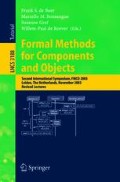Abstract
Attack graphs depict ways in which an adversary exploits system vulnerabilities to achieve a desired state. System administrators use attack graphs to determine how vulnerable their systems are and to determine what security measures to deploy to defend their systems. In this paper, we present details of an example to illustrate how we specify and analyze network attack models. We take these models as input to our attack graph tools to generate attack graphs automatically and to analyze system vulnerabilities. While we have published our generation and analysis algorithms in earlier work, the presentation of our example and toolkit is novel to this paper.
Access this chapter
Tax calculation will be finalised at checkout
Purchases are for personal use only
Preview
Unable to display preview. Download preview PDF.
References
Ammann, P., Wijesekera, D., Kaushik, S.: Scalable, graph-based network vulnerability analysis. In: 9th ACM Conference on Computer and Communications Security, pp. 217–224 (2002)
Ausiello, G., D’Atri, A., Protasi, M.: Structure preserving reductions among convex optimization problems. Journal of Computational System Sciences 21, 136–153 (1980)
Cormen, T.H., Leiserson, C.E., Rivest, R.L.: Introduction to Algorithms. MIT Press, Cambridge (1985)
Cotse.net. Vulnerability Scanners., http://www.cotse.com/tools/vuln.htm
Cuppens, F., Miege, A.: Alert correlation in a cooperative intrusion detection framework. In: 23rd IEEE Symposium on Security and Privacy (May 2002)
Cuppens, F., Ortalo, R.: Lambda: A language to model a database for detection of attacks. In: Debar, H., Mé, L., Wu, S.F. (eds.) RAID 2000. LNCS, vol. 1907, pp. 197–216. Springer, Heidelberg (2000)
Dacier, M.: Towards Quantitative Evaluation of Computer Security. PhD thesis, Institut National Polytechnique de Toulouse (December 1994)
Deraison, R.: Nessus Scanner., http://www.nessus.org
Jha, S., Sheyner, O., Wing, J.M.: Minimization and reliability analyses of attack graphs. Technical Report CMU-CS-02-109, Carnegie Mellon University (February 2002)
Jha, S., Sheyner, O., Wing, J.M.: Two formal analyses of attack graphs. In: Proceedings of the15th IEEE Computer Security FoundationsWorkshop, Nova Scotia, Canada, June 2002, pp. 49–63 (2002)
Jha, S., Wing, J.: Survivability analysis of networked systems. In: Proceedings of the International Conference on Software Engineering, Toronto, Canada (May 2001)
Ortalo, R., Dewarte, Y., Kaaniche, M.: Experimenting with quantitative evaluation tools for monitoring operational security. IEEETransactions on Software Engineering 25(5), 633–650 (1999)
Phillips, C.A., Swiler, L.P.: A graph-based system for network vulnerability analysis. In: New Security Paradigms Workshop, pp. 71–79 (1998)
Ramsdell, J.: Frame propagation. MITRE Corp. (2001)
Ritchey, R.W., Ammann, P.: Using model checking to analyze network vulnerabilities. In: Proceedings of the IEEE Symposium on Security and Privacy, May 2001, pp. 156–165 (2001)
Sheyner, O.:Scenario Graphs and Attack Graphs. PhD thesis, Carnegie Mellon University (2004)
Sheyner, O., Haines, J., Jha, S., Lippmann, R., Wing, J.: Automated generation and analysis of attack graphs. In: Proceedings of the IEEE Symposium on Security and Privacy (2002)
SMV. SMV:ASymbolic Model Checker, http://www.cs.cmu.edu/~modelcheck/
Swiler, L.P., Phillips, C., Ellis, D., Chakerian, S.: Computer-attack graph generation tool. In: Proceedings of the DARPA Information Survivability Conference and Exposition (June 2000)
Templeton, S., Levitt, K.: A requires/provides model for computer attacks. In: Proceedings of the New Security Paradigms Workshop, Cork, Ireland (2000)
Vigna, G., Kemmerer, R.A.: Netstat:A network-based intrusion detection system. Journal of Computer Security 7(1) (1999)
Common Vulnerabilities and Exposures, http://www.cve.mitre.org
Author information
Authors and Affiliations
Editor information
Editors and Affiliations
Rights and permissions
Copyright information
© 2004 Springer-Verlag Berlin Heidelberg
About this paper
Cite this paper
Sheyner, O., Wing, J. (2004). Tools for Generating and Analyzing Attack Graphs. In: de Boer, F.S., Bonsangue, M.M., Graf, S., de Roever, WP. (eds) Formal Methods for Components and Objects. FMCO 2003. Lecture Notes in Computer Science, vol 3188. Springer, Berlin, Heidelberg. https://doi.org/10.1007/978-3-540-30101-1_17
Download citation
DOI: https://doi.org/10.1007/978-3-540-30101-1_17
Publisher Name: Springer, Berlin, Heidelberg
Print ISBN: 978-3-540-22942-1
Online ISBN: 978-3-540-30101-1
eBook Packages: Springer Book Archive

